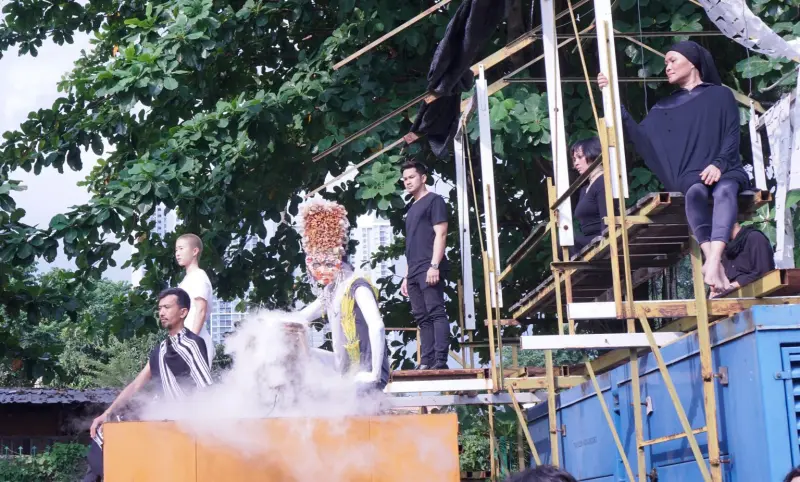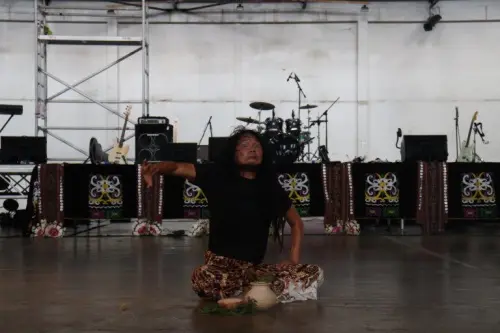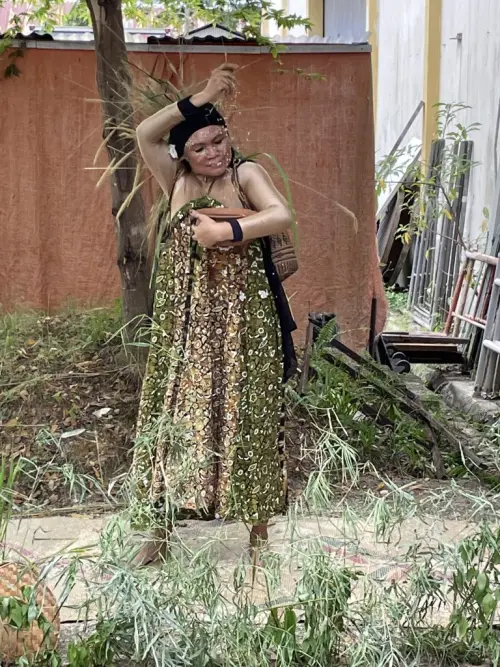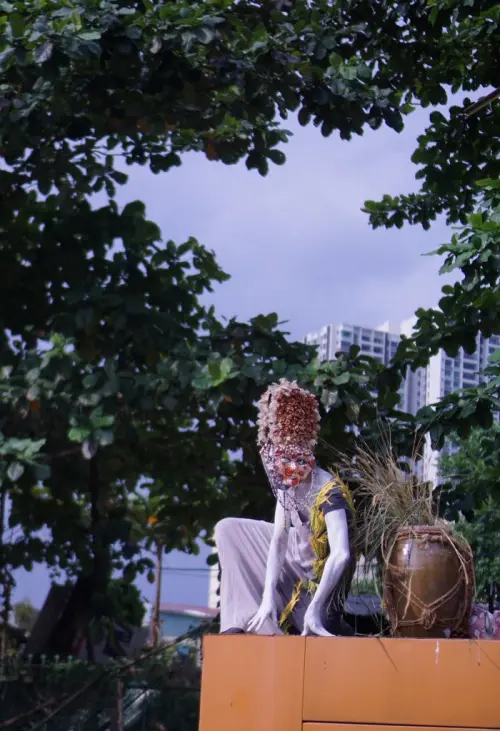Folk Dance in Malaysia: Redefining Cultural Memory
Published on

by Dorothy Cheng
“To understand the culture, study the dance. To understand the dance, study the people.”
The quote above is commonly attributed to Chuck Davis, an American choreographer and dancer focused on traditional African dance. He was known to spotlight and celebrate African dances originating from the villages of Senegal to the suburbs of The Gambia. Evidently, Davis was one of many who saw dance as not only an expression of culture but a valuable lens through which one could study a culture.
The dancers of Tuai, a site-specific dance experiment celebrating the harvest festival in Malaysia, have the same idea.
Just as tribal African dances reflect the diverse cultures and peoples of that continent, what do the different traditional dances in Malaysia have to say about us?
Dance for the Working Classes and Marginalized
There is a perception of dance and the enjoyment of dance as a bit of an elitist activity, stemming from high-brow, classist sensitivities. Those perceptions of performance – as something highly-priced used merely to entertain posh crowds and show off objectively judged technique and skill – can be attributed to the neoliberal thinking of the well-meaning yet ill-executed ideology of certain sects of the Western Enlightenment.
Yet, is folk dance not something that is primarily created, enjoyed and performed by the working class?
As part of Tuai, eight different dances were performed, representing different elements of the harvest as experienced by people living in what we call Malaysia.
The very nature of the harvest is that it is an activity typically performed by the working class. In that sense, Tuai is not only celebrating the spiritual and cultural significance of the harvest, it is also effectively celebrating the working classes that make harvest possible in the first place. Ultimately, it is not the landlords who own the farm or plantation who have the lived experience to create dances inspired by the act of harvest – it is the harvesters who first defined and then mastered those movements.

The dance piece Kerbau, a representation of a trance involving the possession of the dancer’s body by the kerbau spirit, exemplifies this idea of the lived experience.
“My dance practice was trained in a similar fashion to that of a paddy farmer. My legs work in a grounded position. In Asia, especially South East Asia, the physicality of farmers bears a strong connection to local cultural practices.”
So says Kien Faye, the dancer of this piece. In their mind, it is necessary to embody the physicality of a farmer, not just in terms of athleticism, but in terms of the very positions and movements farmers tend to adopt when doing their work. This celebration of the traditional farmer’s physicality is something generally applicable to all cultures – despite the unfairly perceived “unskilled” nature of their jobs, farmers are generally respected as significant contributors to our societies. But how often do we actually acknowledge and recognize them? The first performers of kerbau trances were likely farmers themselves – but does wider society rightfully perceive such working-class people as the originators of culture that they are?

The dance Parai adds another dimension to this idea of recognizing the people who actually create culture. According to dancer Alla, Parai was inspired by the women who are crucial to Indigenous cultural practice and folk legend: Bobohizans and Huminodun.
The legend of Huminodun goes that she was offered up as a sacrifice to save her people from famine. She willingly accepted and became cemented in Kadazan Dusun culture as a hero of the people.
Bobohizans, on the other hand, are high priestesses, ritual specialists and spirit mediums in Kadazan-Dusun rites. As part of her charge, a Bobohizan must work to appease the rice spirit during the harvest festival.
Alla danced Parai not only to honour the bounties mother nature gives us and the farmers who harvest that bounty, but also the mothers and women who have been and still are central to feeding people and communities.
Around the world, women’s unpaid and undervalued labour, especially in care work, is a significant contributor not only to economies but also to the well-being of communities. Malaysia is the same.
“Women start off well in the workforce but gradually decline in participation, employment, hours worked and wages as they grow older, coinciding with childbearing and parenting years. A majority of women cited housework as an impediment.”
How often does our patriarchal society recognize the contributions of women to the economy and society? Even when an acknowledgment is made, are actual changes made in policy and societal outlook that bring on needed improvements to the lives of women?
As liberal society continues to engage with the contributions, both cultural and material, of the working class and marginalized, we must not forget to remember what we owe them in turn.
Dance for Memory
The topic of remembrance brings up the age-old question of the role performance art plays in preserving cultural memory.

Some of the performances in Tuai had the effect of transporting audience members to an older time and place. From the opening herald’s call performed by Melvz to Wak Gelek: The Gudang Show, it is apparent that the performers in Tuai not only conform to their setting in a physical sense (by structuring their dances around the space of their given venue), they also somehow inadvertently make the audience conform to their metaphorical setting by immersing us in a cultural story.
In Wak Gelek, Romo, one of the performers, donned fake facial hair and a wig and put on a character I can only describe as befitting of old black-and-white P. Ramlee films. A duo then performed a silat-inspired dance. Despite my lack of familiarity with the art form, the effect of this “time travel” was not lost on me. I felt transported back to older days when heralds would call townspeople to a gathering place where dances by the folk were performed for the folk… what good old days, right? How nice to be reminded of something I never personally experienced, but somehow have a memory of because I’ve fashioned an image of it from all the movies, documentaries and old-people anecdotes I’ve seen and heard. And then I stopped myself.
It is tricky to talk about time and memory when it comes to tradition. When you say you feel transported back in time by a piece of art, are you implying that that art form is now extinct in the world you live in? Or that, at the very least, it is not modern? I do not think that “modern” and “traditional” are necessarily antonyms. Does being modern mean rejecting tradition? Is modernity not also the ability to live with tradition? We must resist the knee-jerk urge to fetishize traditional art forms as relics, museum dioramas or at best, conduits for us to relive our pasts, whether real or imagined.
Performance art has a unique ability to engage and interact with the audience. Its ability to move space and time is more potent, and as such, its ability to evoke an emotional response is amplified. This is important because when it comes to art, our relationship with memory is not always triggered by actual experience but by emotional memory. We associate certain feelings with certain concepts – for instance: nostalgia, longing, forlornness, comfort or piousness with anything that appears “old” or “traditional”, which can include anything mystic, spiritual or pagan – and feel those feelings authentically even if we have never been a mystic or a pagan ourselves.
When observing the trance performance Kerbau, another dancer described feeling a deep uneasiness and running away from the performance.
“No matter how much we change, we still have a connection to our traditions. There will be triggers,” he said, alluding to the fact that before Islam and even Hinduism, Malay folk religion had strongly-held beliefs around the nature of the spiritual world that may be considered heretical in the monolithic view of religion today.
The dancer in question identifies as a devout Muslim, as do a number of other dancers, but they insist that certain triggers can bring them back to certain beliefs they simply cannot refute.
Another dancer expressed that they participate in folk dance performances as a way to “look back at who we were before religion came.”
One of the dances in Tuai is a tari balai-inspired dance, performed by Firdaus, also known as MarkYong. Tari balai has a bit of a contested status in Malaysia today, with its connections to animist and Hindu-Buddhist roots invoking the wrath of certain factions. Yet, Firdaus believes that this dance must be preserved as a cultural heritage indigenous to Malaysia.
They clarified that it is possible to represent these dances and honour them for their cultural significance without going against their current religious beliefs.
A number of the dances performed are partly inspired by Indigenous folklore depicting gods from those traditions, and both dances showcase performances by Malay dancers.
“Our dance represents the spiritual beliefs of the Kadazan-Dusun. In the Sumazau dance, inspiration is derived from nature, specifically birds. This is the same,” said Ethel, who performed Tari Sila, a duet with K that paid tribute to the traditional spiritual forces of good and evil in Kadazan-Dusun culture.
It cannot be wrong to simply depict something, can it? What happens if you stop depicting it altogether? If it were birds, they would not cease to exist in our collective memory, for they can be observed in the natural world and there is physical evidence remaining even of birds long extinct. But for gods, who live in the hearts and memories of people, a refusal to mention them or depict them will mean they cease to exist.
Or does it? What about the dancer who claimed that triggers will always bring a person back to their ancestral beliefs? The implication here is that these beliefs so strongly shape culture and a person from that culture that its influences can never be fully erased.
It begs the question: what does banning anything actually serve to do? More importantly, who does it serve? In the same vein, why is it necessary to remember these things of yore, these ancient gods, these old ways?
Art, including dance, has a political purpose. They can be made to serve specific political agendas, too. Culture is also political. An insistence to continue representing elements from a culture or art piece that are deemed heretical, unlawful or inappropriate simply speaks to an inherent human tendency in all of us to explore boundaries, break down walls and speak truth to power.
But there is a more personal side to it too: the feeling that something within us is lost when we give up our culture.

The performance Ascend is a story about an Indigenous god exploring the implications of being forgotten by his people. Its performer, Din, says the god is angry.
I think you’re supposed to feel a bit of fear, or at least sheepishness, as Din rounds on you during the performance. By the end of it, he chooses a few people from the audience to absolve, by swiping a little ash on their foreheads. Those he passed over can’t help but feel a small sense of regret. Why do we feel guilt for forgetting our past?
“Religion cannot overtake culture,” said one of the dancers.
“We want the youth to look at our performances and think about where it is they came from and what their roots are,” said Alla.
The truth is, I struggle to see the objective measure of what it is we lose and why it is bad to lose those things. It is natural for cultures to evolve and for people to forget the gods of old. Some cultures even disappear altogether, organically. But the fact is that in my travels, I have noticed people all around the world, and Asians make up a big faction of this, who yearn for more cultural connections with their roots and who feel robbed that they do not have that connection.
That is the difference: changing along with your culture, or having it robbed from you. The world is ruled by a cultural hegemony of capitalism and a restrictive idea of what “civilized” means, ideas which largely originated in the West but have since adapted to local fascist flavours all around the world. When someone is forced to give up their culture or told which parts of their culture are more accepted and which makes them outcast and savage, when push factors remove people from their traditions – that is when people feel like something priceless has been lost, and you can’t help but feel a little guilty for losing something, whether it was your fault or not.
It is no surprise that Tuai exists in Malaysia. With colonization, scores of people living in this land were pushed to quickly adapt to norms set by others. Perhaps the ways of the older generation make more sense now, when they urge us to not forget our traditions: they were robbed, and they now look to us to find the lost pieces.
Dance for Cultural Discovery
Hana, who is Kadazan-Chinese from Sabah, is one such example of a younger person seeking to find those lost pieces.
“My culture was not passed down to me and I don’t live in my tradition.”
The solutions seem like water in the hands of the younger generation. How do we find something that we don’t even know exists? How do we look for something if we don’t know what it looks like?
There is a bit of a global movement among Asians to better represent our culture in art and media. It is safe to say that part of this comes from the aforementioned desire to reconnect with something lost. But how do we know that what we are putting out is authentic?
Is it right to assume that authenticity is necessary for a valid experience of a culture? Do these youth not end up making their own culture when they participate in an experience of culture?
Hana talks about dancing warrior dances from Sabah – a performance typically reserved for men. She says she wants to redefine femininity. In so doing, she is also challenging some traditional aspects of her culture. Personal experience supersedes authenticity – no, becomes authenticity for the dancer.

For Tuai, Hana and Chloe performed Harvest, a deeply personal interpretation of what the titular concept means.
Chloe, who is Chinese, kneels sombrely in the middle of the dancefloor and eats rice from a bowl. Perhaps her experience of her culture is heavily tied to her experience of her culture’s food. I am the same, and yet I can barely speak Mandarin or other Chinese dialects. Is my experience of Chinese culture less valid?
It is an interesting experiment to bring Chloe and Hana together for a reinterpretation of what harvest means. Whatever their intentions, they ended up providing an interpretation of how different cultures in Malaysia interact with each other as well as an interpretation of Malaysian culture as a whole.
In fact, Tuai is full of such harmonies and contradictions. Malay and Chinese dancers perform Indigenous Sarawakian and Sabahan dances as well as incorporate dance motifs from other Malaysian cultures not of their own. Genders are bent. Religious customs are represented by non-believers.
In a different cultural landscape, we may be tempted to bring up the issue of cultural appropriation. But in the context of Malaysia, we must inquire about the value this kind of cross-cultural sharing brings to a society that has traditionally been divided along racial and religious lines.
It is evident from the representation of multiple ethnic groups and cultural dances in Tuai that celebrating the harvest is a concept that is universal among different Malaysian cultures. By coming together and celebrating what the harvest means to each of us, and by partaking in the harvest celebrations of others, we are in effect creating a new culture of shared harvest celebrations that blend motifs, timelines and approaches. We are creating a new culture of remembering and reconnecting with lost aspects of our past and recognizing the corners of society that were previously uncredited for their contributions to culture. We may not have found what was lost, but we are creating something new.
__________________________________________________________________
Tuai was performed at Cuba Dengar Dulu, an event jointly hosted by Article 19 and Projek Dialog.
Quotes used in this article have been edited for brevity and clarity.
This article was an original entry from Projek Dialog. More information can be found at: https://projekdialog.com/blog/folk-dance-in-malaysia-redefining-cultural-memory/